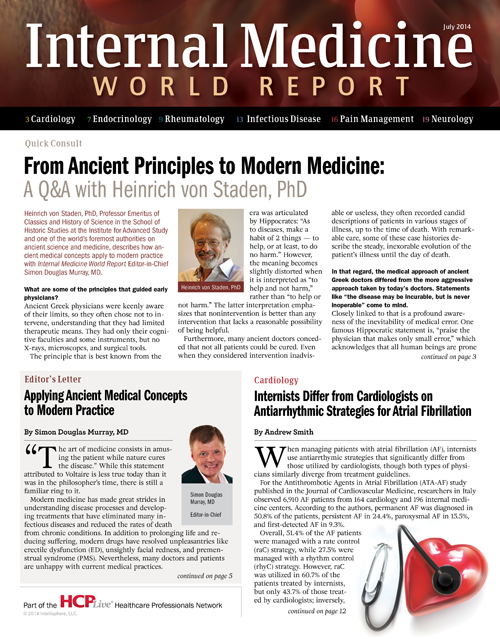Internists Differ from Cardiologists on Antiarrhythmic Strategies for Atrial Fibrillation
When managing patients with atrial fibrillation, internists use antiarrthymic strategies that significantly differ from those utilized by cardiologists, though both types of physicians similarly diverge from treatment guidelines.

When managing patients with atrial fibrillation (AF), internists use antiarrthymic strategies that significantly differ from those utilized by cardiologists, though both types of physicians similarly diverge from treatment guidelines.
For the Antithrombotic Agents in Atrial Fibrillation (ATA-AF) study published in the Journal of Cardiovascular Medicine, researchers in Italy observed 6,910 AF patients from 164 cardiology and 196 internal medicine centers. According to the authors, permanent AF was diagnosed in 50.8% of the patients, persistent AF in 24.4%, paroxysmal AF in 15.5%, and first-detected AF in 9.3%.
Overall, 51.4% of the AF patients were managed with a rate control (raC) strategy, while 27.5% were managed with a rhythm control (rhyC) strategy. However, raC was utilized in 60.7% of the patients treated by internists, but only 43.7% of those treated by cardiologists; inversely, rhyC was used in 39.6% of the patients seen by cardiologists, but only 12.9% of those seen by internists.
Both cardiologists and internists most frequently prescribed beta-blockers and overprescribed amiodarone, which current treatment guidelines recommend only for a small subgroup of patients with structural heart disease, according to the researchers.
“Although, in the past years, much effort has been directed to develop and disseminate guideline recommendations for optimizing AF patient care, in common clinical practice, AF management cannot yet be considered as optimal,” the study authors wrote.
Relevant clinical factors explained some of the variation in treatment. For instance, patients treated with rhyC were, in general, younger and healthier than those treated with raC. Nevertheless, multivariable analysis found AF management strategies were significantly impacted by factors with no clinical relevance, such as whether a patient was hospitalized or treated on an outpatient basis, and which type of doctor a patient visited.
One factor that should have affected treatment strategies but did not was the severity of AF symptoms — an unexpected deviation from guideline recommendations that needs to be corrected by educational campaigns, the researchers said.
Even when patients underwent the same general type of treatment, their care varied significantly by the type of doctor who prescribed it. For example, those assigned to the rhyC strategy by a cardiologist were considerably more likely to undergo electrical cardioversion and exponentially more likely to undergo an ablation than those assigned to rhyC by an internist.
The wide variance among treatment strategies and substantial divergence from evidence-based guidelines showed few signs of benefitting patients, the study authors noted.
“At discharge from hospital/outpatient visit, the target points of the benefit of the given therapy — sinus rhythm in rhyC patients and ventricular rate <80 beats/min in those with AF assigned to raC — were present in approximately two-thirds of the rhyC and one-third of the raC patients,” they wrote. “Although not comparable with the results of other studies because of lack of available data, this therapeutic success rate cannot be considered satisfactory.”
